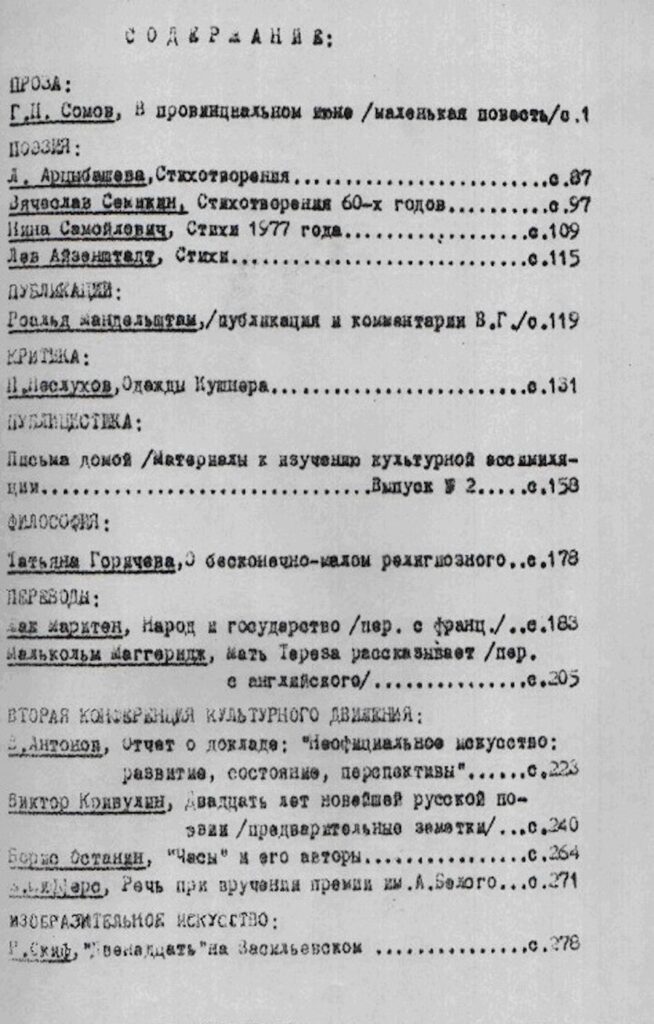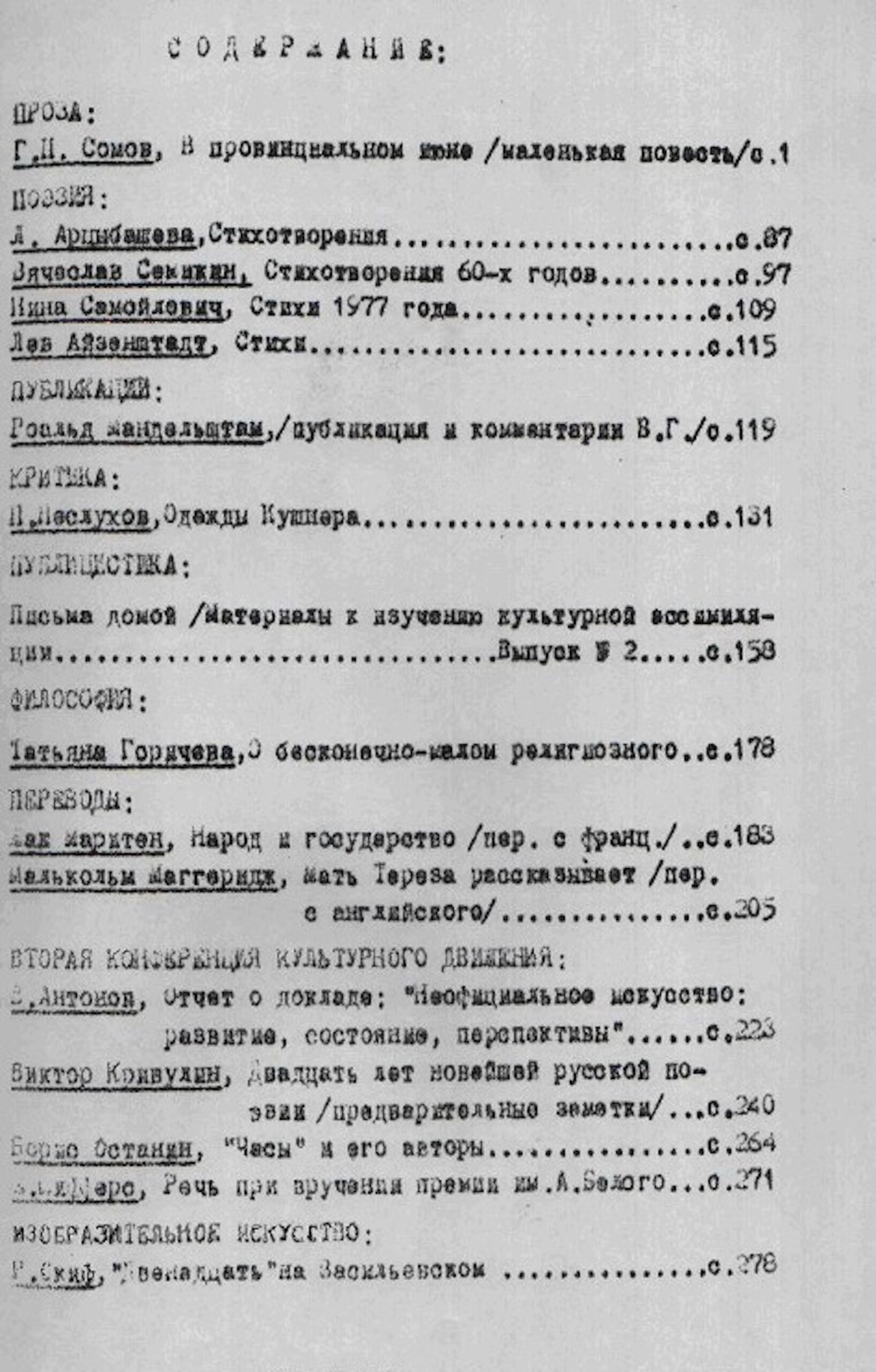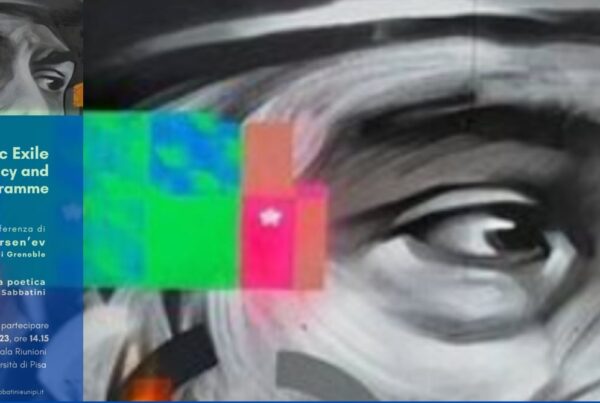
Index of the “Chasy”, n. 22, 1979. Memorial Archive of San Petersburg.
Title:
“Chasy” [The Clock]
Dates: [June] 1976-1990
Place of publication: Leningrad
Editors: Boris Ivanov, Boris Ostanin
Principal collaborators: Igor’ Adamatskii, Viacheslav Dolinin, Arkadii Dragomoschenko, Sergei Korovin, Iurii Novikov, Boris Ostanin, Sergei Sheff, Iuliia Voznesenskaia
Total number of issues: 80
Description:
The periodical was published in Leningrad between 1976 and 1990 directed by Boris Ivanov. It was founded at the same time as the magazine “37” and, had it been published, would have coincided with the release of the Lepta poetry anthology by Sovetskij pisatel’ (cf. Parisi 2013: 97). The name “Chasy” (The Clock) was coined by Ivanov to underline his intention that the periodical be regularly and uninterruptedly published. Indeed, unlike other extemporaneous projects from this time, which were less coordinated or long-lived, “Chasy” was published every two weeks and was the longest running journal to be circulated by samizdat. The success of the journal depended on its committed editorial team as well as the decision to charge between 12 and 15 roubles per copy which paid the typists. The minimum number of copies made was 10 but many others were made clandestinely. Copies of the journal circulated widely, finding their way to Moscow, Kiev, Odessa, Sverdlovsk, Tallinn and Riga. In the early period, there was an attempt to collaborate with the rival Leningrad journal, “37”, which led to the sharing of some resources, but the visions of Viktor Krivulin and Boris Ivanov were too different to bring about a fusion of the two magazines. “37” favoured a more philosophical-religious approach to literature while “Chasy” was more interested in aesthetics, had a broader philosophy and placed greater emphasis on prose and Western literature. These areas was entrusted to Boris Ostanin who from the fourth edition acted as co-editor. Until 1978, the journal was largely a literary almanac, but after the eleventh issue it began to take the form of a literary review, with a greater focus on editorials and the introduction of a news section edited by Iurii Novikov and Sergei Sheff which included descriptions of important unofficial literary and cultural events, such as exhibitions, meetings in private houses, poetry readings, unofficial conferences, and reports to the philosophical-religious seminar (cf. Severiukhin 2003: 463-465). Iurii Novikov, together with Sergei Koval’skii, Sergei Sheff and Viktor Antonov was also responsible for the figurative art section. From 1978 other figures such as Igor’ Adamatskii, Viacheslav Dolinin, Arkadii Dragomoschenko and Sergei Korovin began to collaborate more closely (cf. Sabbatini 2003: 28-32).
A key figure from the first issues was Iuliia Voznesenskaia, who was responsible for the poetry section. The refusal of the state to allow the publication of the Lepta anthology which would have given a voice to unofficial poets in Leningrad had given rise to a proliferation of underground publishing projects, many of which found support among the editors of “Chasy”. Poetry collections by Sergei Stratanovskii, Elena Ignatova, Viktor Krivulin, Leonid Aronzon and Elena Shvarts were published as appendices to the periodical as were prose works by Michail Berg and Arkadii Dragomoschenko and literary criticism by Grigorii Pomerants.
The editors always adopted a flexible approach to content; there were articles on the figurative arts, on musicology – in the 1980s there were articles on rock and jazz (31, 33) – or on scientific questions, for example in n. 33 of 1981. Sometimes there were texts on civil rights and political thought, for example by Revol’t Pimenov (73, 79). In the 1970s, especially, many pieces were included on religion and philosophy, several of which were written by Boris Ivanov himself (for example on existentialism in n. 10), or by Tat’iana Goricheva and Boris Grois (pseud. Suitsidov) who had been part of the “37” editorial team.
Most of the journal’s content, however, focused on prose, poetry, literary criticism and translation. Amongst Leningrad’s prose writers to be published by “Chasy” were Andrei Ar’ev, Arkadii Bartov, Igor’ Adamatskii, David Dar, Evgenii Zviagin and Fedor Khirskov, while amongst the poets were Leonid Aronzon, Roal’d Mandel’shtam, Dmitrii Bobyshev, Petr Brandt, Tamara Bukovskaia, Evgenii Venzel’, Sergei Stratanovskii, Elena Ignatova, Viktor Krivulin, Elena Shvarts, Lev Losev, Oleg Okhapkin, Evgenii Rejna and Eduard Shneiderman. “Chasy” was less exclusive than “37” and published the works of many authors who are not found in other periodicals. Indeed, the works of more than 400 authors were published by “Chasy”, including 100 foreign writers. The journal also gave an important platform to Muscovite writers such as Sergei Gandlevskii, Eduard Limonov, Dmitrii Prigov, Ol’ga Sedakova, Bakhit Kenzheev and Vladimir Aleinikov.
Among the translators who worked for the periodical were M. Iossel’, B. Ostanin, V. Antonov, M. Khanan, S. Khrenov, V. Kucheriavkin and T. Goricheva. An excerpt from The Myth of Sisyphus by Albert Camus translated by Rid Grachev was published in issue n. 3 of 1976 (150-228), which followed Grachev’s own prose work Adamchik which had appeared in the preceding issue (cf. Grachev 2019: 39-78). “Chasy” also published works in translation by C. Castaneda, K. Jaspers, E. Ionesco, S. Beckett, W. Yeats, R. Barthes, C. S. Lewis and A. Robbe-Grillet, all of whom had a significant influence on Leningrad’s literary scene. In 1978, the editors of “Chasy” created the Andrej Belyj Prize, still awarded today, as an alternative to the official Soviet prizes for literature awarded at this time (cf. Sabbatini 2020: 243-247). In 1980 thanks to the guidance of Boris Ivanov and Igor’ Adamatskii, “Chasy” was instrumental in making an agreement with the Soviet authorities which led to the foundation of Klub-81 in Leningrad, an association controlled by the authorities of unofficial artists and writers with the aim of bringing into the light and publishing clandestine works that had been circulated by samizdat (cf. Ivanov 2015: 14-76). In number 35 of 1981 (292-297), there appeared a detailed account of the birth of Klub-81 and the text of its statute. Throughout the 1980s, the periodical represented a free space for debate and for documenting the activities of Klub-81 as well as a focus for the discussions fuelled by the publication of the Krug anthology of poetry(1985), by Sovetskii Pisatel’. In the periodical’s last issue (80, 1990), in the final section titled K istorii kul’turnogo dvizheniia (To the history of the cultural movement), Igor’ Adamatskii published some extracts of the book he was writing, with the title Klub-81 (vnutri i riadom). This was the final statement of the journal, which stopped publishing when the censorship laws were repealed, freedom of the press returned, and editorial restrictions lifted.
Notes: The periodical usually published 10 editions a year, of between 200 and 300 pages each. Cataloguing was based on the digitalised copy of the samizdat collection of the Andrei Belyi Centre in San Petersburg. Original copies are kept at the Memorial Archive of San Petersburg and at Forschungsstelle Osteuropa – FSO Research Centre for Eastern European Studies at the University of Bremen, now published in the Electronic Archive Project for the Study of Dissidence and Samizdat at the University of Toronto.
Marco Sabbatini
[30th June 2021]
Translation by Tammy Corkish
Bibliography
- Arkhiv Tsentra Andreia Belogo, Sankt-Peterburg, http://samizdat.wiki/index.php/Архив_журнала_«Часы», online (last accessed: 30/06/2021).
- Dolinin V., Ivanov B., Ostanin B. Severiukhin D. (eds.), Samizdat Leningrada. 1950-e – 1980-e. Literaturnaia Ėnciklopediia, Novoe Literaturnoe Obozrenie, Moskva 2003.
- Forschungsstelle Osteuropa – FSO Research Centre for Eastern European Studies at the University of Bremen , https://www.forschungsstelle.uni-bremen.de/, online (last accessed: 30/06/2021).
- Gračev R., Adamchik (1962), it. transl. Adamčik. Un eroe neorealista nella Russia sovietica, M. Sabbatini (ed.), translation by Marta Capossela, Pisa University Press, Pisa 2019.
- Ivanov B., Istoriia Kluba-81, Izdatel’stvo Ivana Limbakha, Sankt-Peterburg 2015.
- Komaromi A. (ed.), Project for the Study of Dissidence and Samizdat, University of Toronto, https://samizdatcollections.library.utoronto.ca/islandora/object/samizdat%3Achasy, online (last accessed: 30/06/2021).
- Parisi V., Il lettore eccedente. Edizioni periodiche del samizdat sovietico, 1956-1991, Il Mulino, Bologna 2013.
- Sabbatini M., Voci dal samizdat di Leningrado. Incontri con Vjačeslav Dolinin, Tamara Bukovskaja, Ėduard Šnejderman, “eSamizdat”, 1 (2003): 27-37.
- Sabbatini M., “Quel che si metteva in rima”: cultura e poesia underground a Leningrado, Collana di Europa Orientalis, Salerno 2008.
- Sabbatini M., Leningrado underground. Testi, poetiche, samizdat, WriteUp, Roma 2020.
To cite this article:
Marco Sabbatini, Chasy, in Voci libere in URSS. Letteratura, pensiero, arti indipendenti in Unione Sovietica e gli echi in Occidente (1953-1991), a cura di C. Pieralli, M. Sabbatini, Firenze University Press, Firenze 2021-, <vocilibereurss.fupress.net>.
eISBN 978-88-5518-463-2
© 2021 Author(s)
Content license: CC BY 4.0





